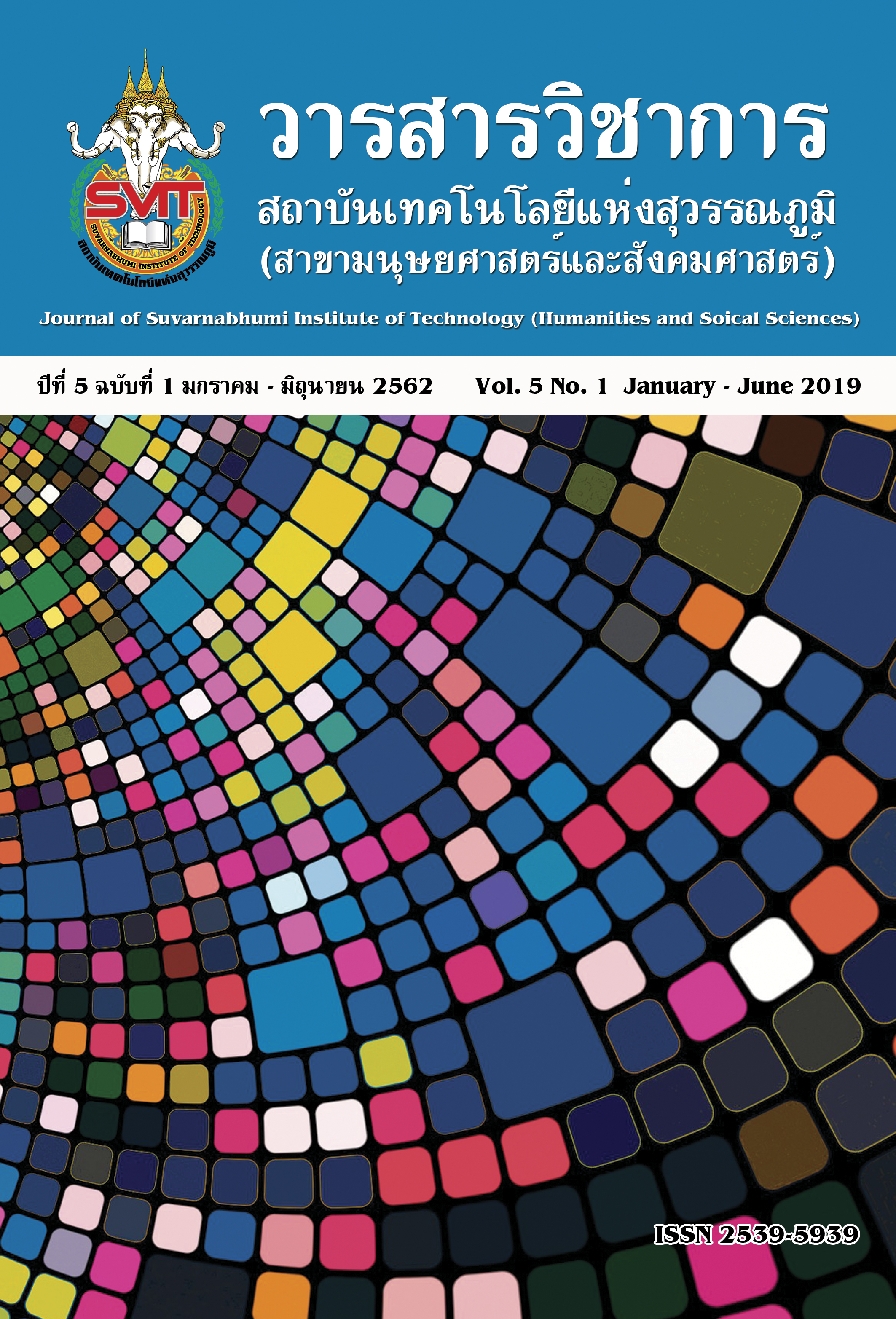การศึกษาพฤติกรรมการสื่อสาร การใช้ประโยชน์และความพึงพอใจ จากการใช้สื่อสังคมออนไลน์ เพื่อสร้างเครือข่ายกลุ่มแฟนคลับหมอลำ : กรณีศึกษาเฟซบุ๊กแฟนเพจ กลุ่ม “เทพไหล”
คำสำคัญ:
สื่อสังคมออนไลน์, แฟนคลับหมอลำ, เฟซบุ๊กแฟนเพจบทคัดย่อ
การศึกษาวิจัยครั้งนี้มีวัตถุประสงค์ เพื่อ 1) ศึกษาพฤติกรรมการใช้สื่อของสมาชิก เฟซบุ๊กแฟนเพจ เทพไหล 2) ศึกษาการใช้งานฟังก์ชันบน เฟซบุ๊กแฟนเพจ เทพไหล 3) ศึกษาการใช้ประโยชน์จากข้อมูลข่าวสารบน เฟซบุ๊กแฟนเพจ เทพไหล และ 4) ศึกษาความพึงพอใจของสมาชิกที่มีต่อ เฟซบุ๊กแฟนเพจ เทพไหล
กลุ่มตัวอย่างที่ใช้ในการศึกษาวิจัยในครั้งนี้ได้แก่ สมาชิก เฟซบุ๊กแฟนเพจ เทพไหล จำนวน 100 คนได้มาโดยการสุ่มตัวอย่างแบบเจาะจง (Purposive Sampling) เครื่องมือที่ใช้ในการศึกษาวิจัยได้แก่ แบบสอบถามพฤติกรรมการสื่อสาร การใช้ประโยชน์และความพึงพอใจจากการใช้สื่อสังคมออนไลน์เพื่อสร้างเครือข่ายกลุ่มแฟนคลับหมอลำ กลุ่มเทพไหลจำนวน 1 ชุด ตรวจสอบความเที่ยงตรงเชิงเนื้อหา (Content Validity) ภาษาที่ใช้ และการประเมินที่ถูกต้อง IOC จากผู้เชี่ยวชาญจำนวน 3 ท่าน ทั้งนี้ในการวิเคราะห์ข้อมูลใช้สถิติเชิงพรรณนา ได้แก่ การคำนวณหาค่าร้อยละ ค่าเฉลี่ย และค่าเบี่ยงเบนมาตรฐาน
ผลการวิจัยพบว่า 1) ผลการวิเคราะห์ข้อมูลทั่วไปของผู้ตอบแบบสอบถาม พบว่าส่วนใหญ่เป็นเพศทางเลือก คิดเป็นร้อยละ 71 มีอายุ 21-30 ปี คิดเป็นร้อยละ 49 มีรายได้มากกว่า 30,000 บาท ต่อเดือนคิดเป็นร้อยละ 25 ส่วนใหญ่สำเร็จการศึกษาชั้นปริญญาตรี คิดเป็นร้อยละ 58 2) พฤติกรรมการใช้สื่อของสมาชิก เฟซบุ๊กแฟนเพจ เทพไหล พบว่ามีความถี่สูงสุดในการใช้ เฟซบุ๊ก มากกว่า 12 ครั้งต่อวันคิดเป็นร้อยละ 74 และใช้เฟซบุ๊กแฟนเพจ เทพไหล 4-6 ครั้งต่อวันคิดเป็นร้อยละ 34 โดยมีระยะเวลาการใช้งานแต่ละครั้งมากกว่า 30 นาที คิดเป็นร้อยละ 67 และร้อยละ 42 ตามลำดับ ส่วนใหญ่เปิดใช้งานเฟซบุ๊กแฟนเพจที่บ้าน หอพัก หรือคอนโดมิเนียม คิดเป็นร้อยละ 79 และช่วงเวลาที่เข้าใช้งานมากที่สุด ได้แก่ช่วงกลางคืน เวลา 19.00-20.00 น. คิดเป็นร้อยละ 59 3) สมาชิกกลุ่มเทพไหลใช้งานฟังก์ชันบนเฟซบุ๊กแฟนเพจ เทพไหล อย่างหลากหลาย โดยใช้ฟังก์ชัน กดไลค์ ความคิดเห็น (Like comment) และฟังก์ชันกดไลค์ พร้อมแสดงความคิดเห็น (Like/other Expressions With Comment) มากที่สุด และฟังก์ชัน กดไลค์ พร้อมแสดงความคิดเห็น (Like/other Expressions With Comment) มากที่สุด คิดเป็นร้อยละ 98 นอกจากนั้นร้อยละ 92 ยังมีการใช้ฟังก์ชัน กดไลค์แสดงความชื่นชอบ (Like) ร้อยละ 90 ใช้ฟังก์ชันกดแชร์ หรือส่งต่อ (Share) และ ทั้งชมวีดีโอ (View Videos) 4) สมาชิกกลุ่มเทพไหล มีการใช้ประโยชน์จากข้อมูลข่าวสาร บนเฟซบุ๊กแฟนเพจเทพไหลอยู่ในระดับมาก โดยข้อมูลเกี่ยวกับการอนุรักษ์วัฒนธรรมพื้นบ้านหมอลำ และติดตามข้อมูลศิลปวัฒนธรรมพื้นบ้านที่กำลังเป็นที่นิยม ที่ได้จาก เฟซบุ๊กแฟนเพจ เทพไหลและ 5) สมาชิกกลุ่มเทพไหล มีความพึงพอใจต่อเฟซบุ๊กแฟนเพจ เทพไหล อยู่ในระดับมาก
เอกสารอ้างอิง
กาญจนา แก้วเทพ และ นิคม ชัยขุนพล. (2555). คู่มือสื่อใหม่ศึกษา . กรุงเทพฯ: ห้างหุ้นส่วนจำกัดภาคพิมพ์จำกัด.
กาญจนา โชคเหรียญสุขชัย. (2560). กระบวนการวิจัยสื่อสารมวลชน เชิงคุณภาพ เชิงปริมาณ และผสมวิธี.กรุงเทพฯ: สำนักพิมพ์จุฬาลงกรณ์มหาวิทยาลัย.
กัญจน์ ผลภาษี. (2554). แนวทางการใช้สื่อสังคมออนไลน์ (Facebook) ในการเรียนการสอน. (คณะอุตสาห กรรมบริการ, วิทยาลัยดุสิตธานี).
ดวงกมล ชาติประเสริฐ และศศิธร ยุวโกศล. (2556). พฤติกรรมและการใช้ประโยชน์จากเว็บไซค์เครือข่ายสังคมเฟซบุ๊ค, วารสารวิชาการมนุษยศาสตร์และสังคมศาสตร์. 21(36), 35-57.
ภาณุวัฒน์ กองราช. (2554). พฤติกรรมการใช้เครือข่ายสังคมออนไลน์ของวัยรุ่นในประเทศไทย: กรณีศึกษา Facebook . (วิทยานิพนธ์ปริญญามหาบัณฑิต, มหาวิทยาลัยธรรมศาสตร์).
พวงรัตน์ ทวีรัตน์. (2540). วิธีการวิจัยทางพฤติกรรมศาสตร์และสังคมศาสตร์. กรุงเทพมหานคร. จุฬาลงกรณ์มหาวิทยาลัย.
มงคล โสภณ. (2556). พฤติกรรมการใช้เฟสบุ๊คของสมาชิกในแฟนเพจสายการบินต้นทุนต่ำ. วารสารการจัดการ. 4(1), 23-38.
ล้วน สายยศ และ อังคณา สายยศ. (2538). เทคนิคการวิจัยทางการศึกษา. พิมพ์ครั้งที่ 5.กรุงเทพมหานคร: บริษัท สุวีริยาสาสน์ จำกัด .
วิภาวี จันทร์แก้ว. (2559) . พฤติกรรมการเปิดรับสื่อ ทัศนคติ และการใช้ประโยชน์ กรณีศึกษาเฟซบุ๊กแฟนเพจดังตฤณแฟนคลับ. วารสารการสื่อสารและการจัดการนิด้า. 2(1), 134-152.
สุกัญญา ลัคนานิธิพันธุ์.(2560 มิถุนายน). การวิเคราะห์ความหมายของการกดไลก์ (Like) การคอมเมนต์ (Comment)และการแชร์(Share)บนเฟซบุ๊ก(Facebook)ในบริบทของคนไทย. สืบค้นจาก https://www.brandbuffet.in.th/2017/06/facebook-like-button-implications/ (7 เมษายน 2561).
หอสมุดแห่งชาติเฉลิมพระเกียรติสมเด็จพระนางเจ้าสิริกิติ์ พระบรมราชินีนาถ นครพนม.(2553 สิงหาคม). องค์ความรู้เรื่องหมอลำ. สืบค้นจาก https://www.finearts.go.th/nakhonphanomlibrary/ parameters/km/item/%E0%B8%AB%E0%B8%A1%E0%B8%AD%E0%B8%A5%E0%B8%B3/ .(1 พฤศจิกายน 2560).
Best, John W. (1986). Research in Education. New Jersey : Prentice Hall Tnc.
Phutthawan Kaewket .(2559 กันยายน). เครือข่ายสังคมออนไลน์. สืบค้นจากhttps://phutthawan. blogspot.com/ ( 30 ตุลาคม 2560).
Praimpat Trakulchokesatiean .(กรกฎาคม 2558). คำอธิบายทางจิตวิทยา เบื้องหลังการไลค์ แชร์ และคอมเมนต์ใน Facebook ที่นักการตลาดควรรู้ สืบค้นจาก https://thumbsup.in.th/2015/07/ the-psychology-behind-why-we-like-share-and-comment-on-facebook (5 พฤศจิกายน 2560).
ดาวน์โหลด
เผยแพร่แล้ว
ฉบับ
ประเภทบทความ
สัญญาอนุญาต
บทความที่ได้รับการตีพิมพ์เป็นลิขสิทธิ์ของวารสารวิชาการ สถาบันเทคโนโลยีแห่งสุวรรณภูมิ
ข้อความที่ปรากฏในบทความแต่ละเรื่องในวารสารวิชาการเล่มนี้เป็นความคิดเห็นส่วนตัวของผู้เขียนแต่ละท่านไม่เกี่ยวข้องกับสถาบันเทคโนโลยีแห่งสุวรรณภูมิ และคณาจารย์ท่านอื่นๆในสถาบันฯ แต่อย่างใด ความรับผิดชอบองค์ประกอบทั้งหมดของบทความแต่ละเรื่องเป็นของผู้เขียนแต่ละท่าน หากมีความผิดพลาดใดๆ ผู้เขียนแต่ละท่านจะรับผิดชอบบทความของตนเองแต่ผู้เดียว





